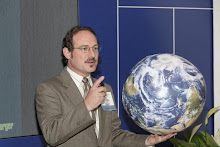In following up the scientific response to the BP Gulf of Mexico Oil Spill (yes the media tagged it and it will never be the "Cameron BOP spill" or the "Anadarko Joint Venture spill"), there is some real insight from those who deal every day with complex technological ventures. In a pretty good indication that, yes, scientists are the pragmatic lot that we expect and need them to be, I have now come across at least two admissions in technical and scientific and publications that when it comes to huge expensive undertakings like deep offshore drilling, the next spill is not a matter of if, but when.
When the National Oceanic and Atmospheric Administration(NOAA)stood up their GeoPlatform website in response to the spill, their CIO was quite candid in noting that they were already planning how the IT infrastructure would have to evolve in order to meet the "next crisis". See:
http://gcn.com/articles/2010/07/15/noaa-cio-kilmavicz.aspx
And Case Western Reserve University has received a grant from the National Science Foundation to study an aerogel material that can soak up eight times its weight in oil, and then be wrung out and re-used. The goal is to lower the cost of the gel so it can be used "during the next big spill".
Those who launch people into space, build high energy physics labs, or even integrate complex software suites, and do it under budgetary constraints, live with a harsh reality. The technicians who are even today, as Paul Carter describes in "This is Not a Drill", designing the "whole fleets of brand new sixth generation, fly by wire cyber rigs ... getting spat out of shipyards all over the world at the moment" ... they know it.
When you push the technology to its limits, sooner or later, something will go wrong.
Saturday, February 19, 2011
Subscribe to:
Post Comments (Atom)

No comments:
Post a Comment